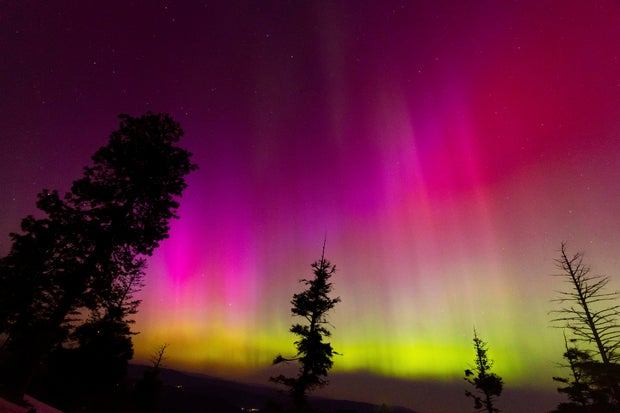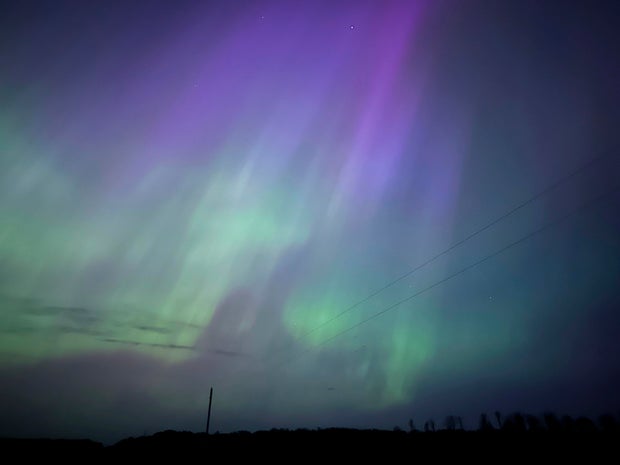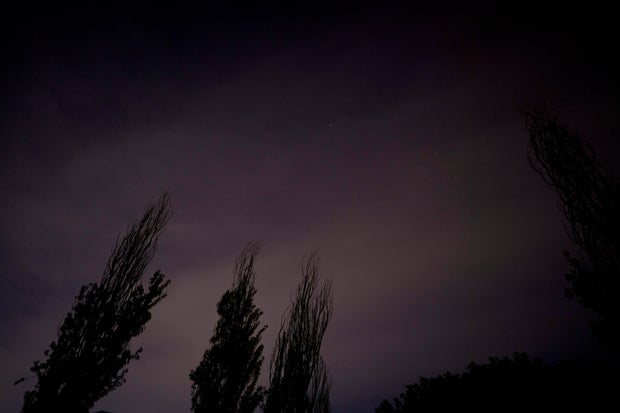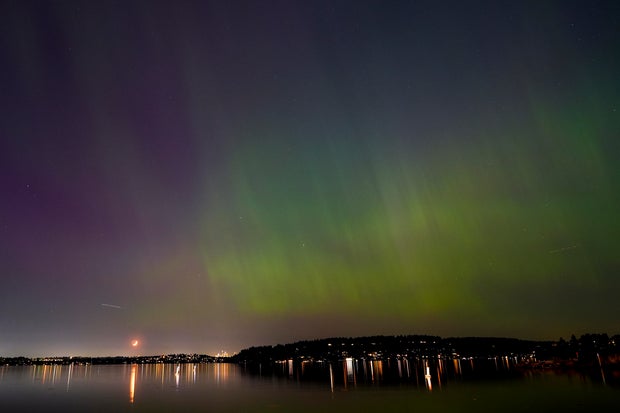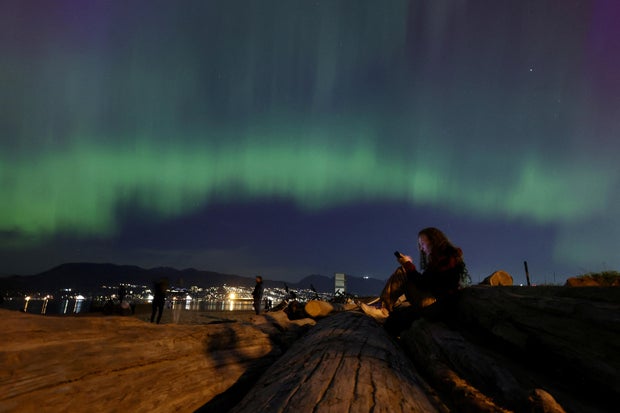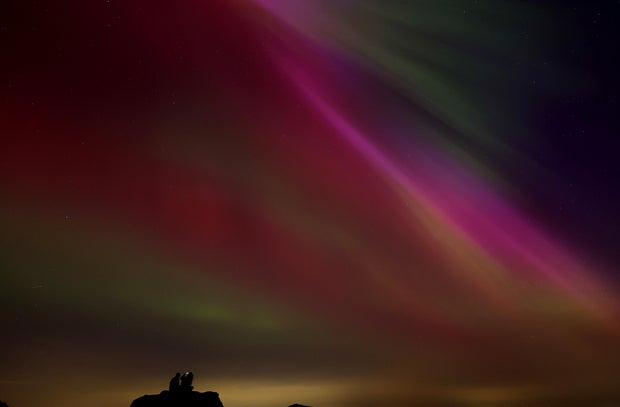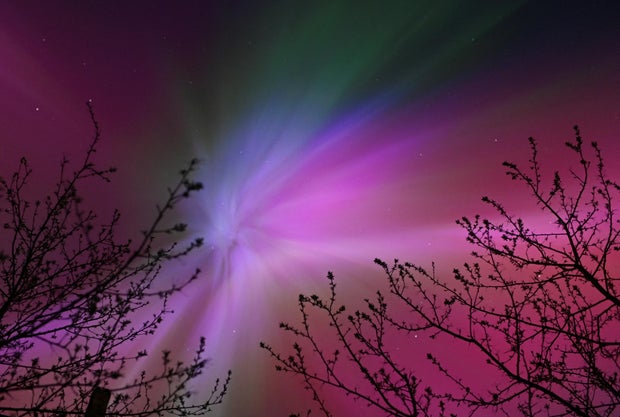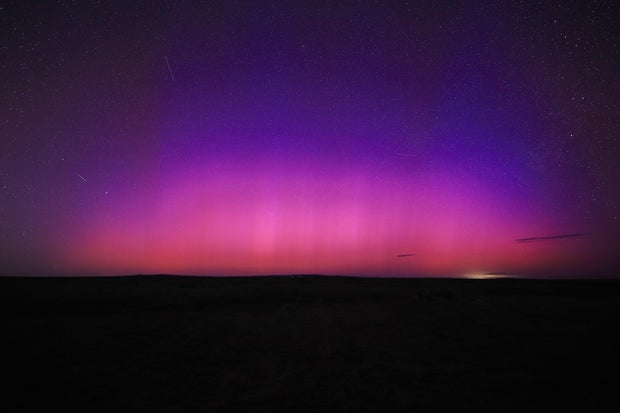CBS News
Spectacular photos show the northern lights around the world

A series of powerful solar storms colored skies across the Northern Hemisphere this weekend, as people witnessed brilliant displays of the northern lights in the United States, Canada, Europe, China and beyond. Officials have said the dazzling light shows could continue for several more days.
The aurora borealis — the phenomenon more commonly known as the northern lights — happens because of a molecular collision in the upper levels of Earth’s atmosphere that causes bursts of energy to be released in the form of visible light. The aurora borealis has a counterpart, the aurora australis, or southern lights, which is the same phenomenon in the southern hemisphere. These light shows can be visible for as much as half the year in certain places near either of the planet’s two poles, but it’s uncommon to see them in areas that are closer to the equator, which is why the spectacles over North America, Europe and other places on similar latitutdes were such a treat in the last few days.
The aurora will extend from the poles toward the equator in periods of intense space weather activity, and it has been known in the past to reach as far as the continental U.S. when the activity is particularly extreme. That was the case over the weekend, as an unusually strong geomagnetic storm reached Earth and set the stage for a string of explosive nighttime scenes world over. The geomagnetic storm that arrived on Friday was a historic G5, the highest level on a ranking scale that starts at G1, according to the National Oceanic and Atmospheric Administration.
A solar storm of that size has not come into contact with Earth in decades. It arrived in the midst of a parade of coronal mass ejections — eruptions of magnetic field and other solar material from the Sun’s corona that can cause geomagnetic storms — which continued to fuel the northern lights shows throughout Friday and Saturday. The next bursts of solar material are expected to arrive at Earth midday on Sunday, according to NOAA’s Space Weather Prediction Center, which issued a geomagnetic storm watch in anticipation of G4 or G5 events likely following those upcoming coronal mass ejections.
“Watches at this level are very rare,” the space weather prediction center said in an advisory on Saturday. It noted that the oncoming solar activity could potentially cause the aurora to “become visible over much of the northern half of the country, and maybe as far south as Alabama to northern California.”
Ahead of the next round of solar flares, here’s a look at some brilliant auroras that have materialized so far this weekend in different parts of the world.
Kyle Green / AP
Charlie Riedel / AP
Dee-Ann Durbin / AP
Robert F. Bukaty / AP
Owen Caputo Sullivan / AP
Jenny Kane / AP
Julio Cortez / AP
Lindsey Wasson / AP
Chris Helgren / REUTERS
Carl Recine / REUTERS
Kacper Pempel / REUTERS
Alexey Malgavko / REUTERS
VCG/VCG via Getty Images
CBS News
Taste-testing “Sandwiches of History” – CBS News

Watch CBS News
Be the first to know
Get browser notifications for breaking news, live events, and exclusive reporting.
CBS News
“Sandwiches of History”: Resurrecting sandwich recipes that time forgot

Barry Enderwick is eating his way through history, one sandwich at a time. Every day from his home in San Jose, California, Enderwick posts a cooking video from a recipe that time forgot. From the 1905 British book “Salads, Sandwiches and Savouries,” Enderwick prepared the New York Sandwich.
The recipe called for 24 oysters, minced and mixed with mayonnaise, seasoned with lemon juice and pepper, and spread over buttered day-old French bread.
Rescuing recipes from the dustbin of history doesn’t always lead to culinary success. Sampling his New York Sandwich, Enderwick decried it as “a textural wasteland. No, thank you.” Into the trash bin it went!
But Enderwick’s efforts have yielded his own cookbook, a collection of some of the strangest – and sometimes unexpectedly delicious – historical recipes you’ve never heard of.
Harvard Common Press
He even has a traveling stage show: “Sandwiches of History Live.”
From the condiments to the sliced bread, this former Netflix executive has become something of a sandwich celebrity. “You can put just about anything in-between two slices of bread,” he said. “And it’s portable! In general, a sandwich is pretty easy fare. And so, they just have universal appeal.”
Though the sandwich gets its name famously from the Fourth Earl of Sandwich, the earliest sandwich Enderwick has eaten dates from 200 B.C.E. China, a seared beef sandwich called Rou Jia Mo.
He declared it delicious. “Between the onions, and all those spices and the soy sauce … oh my God! Oh man, this is so good!”
While Elvis was famous for his peanut butter and banana concoction, Enderwick says there’s another celebrity who should be more famous for his sandwich: Gene Kelly, who he says had “the greatest man sandwich in the world, which was basically mashed potatoes on bread. And it was delicious.”
Whether it’s a peanut and sardine sandwich (from “Blondie’s Cook Book” from 1947), or the parmesian radish sandwich (from 1909’s “The Up-To-Date Sandwich Book”), Enderwick tries to get a taste of who we were – good or gross – one recipe at a time.
RECIPE: A sophisticated club sandwich
Blogger Barry Enderwick, of Sandwiches of History, offers “Sunday Morning” viewers a 1958 recipe for a club sandwich that, he says, shouldn’t work, but actually does, really well!
MORE: “Sunday Morning” 2024 “Food Issue” recipe index
Delicious menu suggestions from top chefs, cookbook authors, food writers, restaurateurs, and the editors of Food & Wine magazine.
For more info:
Story produced by Anthony Laudato. Editor: Chad Cardin.
CBS News
The cream of the crop in butter

Watch CBS News
Be the first to know
Get browser notifications for breaking news, live events, and exclusive reporting.


